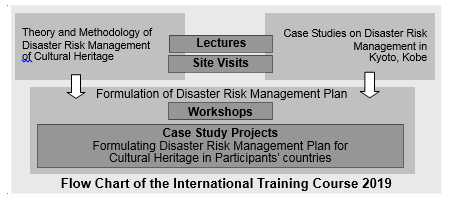Disasters and Cultural Heritage
Several catastrophic disasters in recent years such as Christchurch, Haiti and Chile Earthquakes of 2010, Great East Japan (Tohoku) Earthquake and Tsunami and Thailand Floods in 2011, Hurricane Sandy affecting New York in 2012, Typhoon Haiyan affecting Philippines in 2013, Balkan floods in 2014, Nepal earthquake in 2015, West Japan, Central Italy and Myanmar earthquakes in 2016, Earthquakes in Central Mexico in 2017 and Fire in the National Museum of Brazil in 2018 have caused extensive damage to rich tangible and intangible; movable and immovable cultural heritage located in these areas.
However, cultural heritage is at risk not only from impending disasters but is also exposed to various risks during emergency and post-disaster recovery and reconstruction phases. Various factors that increase vulnerability of cultural heritage to disasters include urbanization and development pressures, lack of maintenance due to ignorance and poverty, loss of local knowledge and capacity and inefficient management systems.
In order to reduce disaster risks to cultural heritage sites and museums, it is important to develop integrated disaster risk management (DRM) plans based on comprehensive risk assessment. These plans should include various mitigation measures at policy, planning and technological levels, emergency preparedness and response procedures and post disaster recovery and rehabilitation measures. Moreover, the DRM plan should be well linked to the management systems of cultural heritage site/museum and the overall disaster risk management systems of the city or region in which particular cultural heritage is located.
Background of the Training Programme
A thematic meeting on Cultural Heritage Risk Management was held in Kobe, Japan, in January 2005, as part of the World Conference on Disaster Reduction (WCDR). The meeting adopted a declaration that recognized the close relationship between the protection of cultural heritage and socio-economic development.
In response to the recommendations of the Conference, R-DMUCH has been acting as a focal point for organizing international research, training and information network in the field of cultural heritage risk management and disaster mitigation.
The past training courses has been participated by 140 participants in total from 60 countries; East Asia (Indonesia, South Korea, China, Philippines, Malaysia, Myanmar, Vietnam, Thailand and Laos), South Asia (India, Pakistan, Bangladesh, Nepal, Bhutan, Sri Lanka and Maldives), Oceania (Palau, Fiji, New Zealand and Australia), Central and South America (Peru, Chile, Jamaica, Haiti, Colombia, Mexico, Ecuador, Honduras, Brazil and Panama), Europe (Serbia, Moldova, Italy, Albania, Croatia, Bosnia and Herzegovina, Spain, Netherlands, Romania, France, Georgia and Belgium), Middle East (Iran, Iraq, Turkey, Afghanistan, Syria, Palestine, and Jordan), Africa (South Africa, Ghana, Kenya, Uganda, Nigeria, Tanzania, Egypt, Morocco, Malawi, Ethiopia and Zimbabwe).
Objective:
The main objective of the course is to provide an overview of the various aspects of disaster risk management of cultural heritage. In particular, the course provides interdisciplinary training to:
- Undertake an integrated risk assessment of tangible and intangible, immovable and movable cultural heritage by analyzing their vulnerability to disasters caused by natural and human induced hazards;
- Build an integrated system for disaster risk management of cultural heritage, incorporating prevention/mitigation, preparedness, response and recovery measures;
- Formulate disaster risk management plans for cultural heritage that correspond to the local / urban and regional disaster management and development plans and policies and humanitarian response and recovery mechanisms;
- To learn practical tools, methodologies and skills for disaster risk management of cultural heritage such as cost benefit analysis, value assessment, budgeting and communication methods with decision makers such as mayors.
- Reinforce the international scientific support network in order to build the institutional capacity needed to formulate comprehensive disaster risk management plans that are based on the characteristics of cultural heritage and nature of hazards in the national and regional context.
Target Audience of the Course:
A. From Cultural Heritage Conservation and Management
- The Professional Staff Members of International, Regional, National, Provincial and Local Heritage Organizations, Departments from Government such as Department of Archaeology
- Cultural Heritage Professionals working in Heritage Sites and Museums in Public and Private Sector and caretakers/custodians of religious sites and communities.
- Urban Planners / Development Practitioners working in the field of management of cultural heritage.
- Researchers, Lecturers and Doctoral Scholars working in the field of Cultural Heritage from Academic Institutions and Research Organizations
- NGOs working in the field of Cultural Heritage conservation and management
- Private Professionals working in the field of Cultural Heritage Conservation
B. From Disaster Risk Management
- Professional Staff Members from International, Regional, National, Provincial and Local Organizations and Departments from Government.
- Members of International, regional and national Humanitarian Response Agencies
- Urban Planners / Development Practitioners working in the field of disaster risk management.
- Researchers, Lecturers and Doctoral Scholars working in the field of disaster risk management from academic institutions and research organizations.
- NGOs working in the field of disaster risk management.
- Private Professionals working in the field of Disaster Risk Management.
C. From both Cultural Heritage Conservation/Management and Disaster Risk Management.
- Combined skill set from A and B.
- Security and facilities staff from heritage sites and muse
Structure of the Course:
The training course would include classroom lectures, field based learning through site visits and practical demonstrations at the Cultural Heritage Sites and Museum in Kyoto and Kobe, along with workshops, team projects, discussions and individual/group presentations.

The participants are supposed to work in multidisciplinary teams to learn the principles and practical know-how for balancing disaster management measures with those needed for conserving the values of cultural heritage. These would help towards disaster risk management of cultural heritage sites by taking into consideration the nature of cultural heritage and the socio-economic and institutional context of respective countries of participants.
During the course, R-DMUCH will also provide various kinds of academic support to the participants to help them develop risk management plans for particular cultural heritage sites in their home countries. Therefore each participant will select one cultural heritage site or museum in his/her respective country before attending the course.
